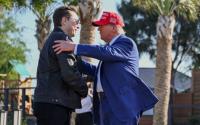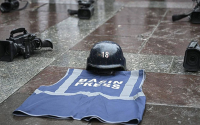21 October 2005John Embry and Andrew Hepburn
[John Embry and Andrew Hepburn provide a valuable entry into the world of finance. The two analysts illuminate the shadowy trail of the "Plunge Protection Team" in its apparent mission to rig the American stock markets. Their account is backed up by considerable indirect evidence as well as statements by credible insiders. If their account is correct, it means that US markets look a lot like the Japanese markets that were long derided for being a site of repeated official manipulation. A more important conclusion may be that US markets are even shakier than many believe.The trail that the two analysts follow is long, dating back to just after Black Monday, October 19 1987. On that day, the US stock market abruptly crashed. The Dow Jones average dropped by 508 points, to 1738. It threatened to do even worse the next day when, after a brief rally it went into reverse. The markets seemed on the edge of a meltdown, but the abyss failed to open up. This lack of a meltdown has generally been attributed to the Federal Reserve Board's (FRB) steady hand and promises of liquidity. But sophisticated research on the events of those two days indicates that a sudden and unprecedented rise in the Major Market Index (MMI) sparked a recovery across the board. There is good reason to suspect that this recovery was the result of concentrated buying by a few firms.
It was after this crash that the President's Working Group on Financial Markets was put in place to prevent destabilizing declines. The Plunge Protection Team was institutionalized in 1989 as a follow-up from this working group, and originally included the top public-sector financial authorities. Its role was apparently tested with the Friday, October 13 1989 stock crash. In this case, too, a sudden rush of aggressive buying of index futures contracts via the MMI saved the day. There appear to have been a considerable number of interventions in the wake of that, with the group expanding to include the heads of major banks. Thus, for example, the markets after September 11, 2001, received a heavy dose of intervention. The need for this intervention was so great that its outlines emerged quite clearly in the press.The Japanese, not surprisingly, appear to be part of the scheme as well. The authors show that there was plenty of consultation between Japanese financial authorities and their American counterparts in the lead-up to the Iraq War. There are also strong indications that the markets were not left unfettered, to render their own verdict on the wisdom of the war, in the anxious days leading up to its outbreak.There is abundant evidence adduced in the article. It is important to note that the authors are not against intervention per se. They note that letting plunging markets fix themselves could result in economic chaos. But they do warn that the secrecy and growing involvement of private-sector actors threatens to foster enormous moral hazards. Major financial institutions may be acting as de facto agencies of the state, and thus not competing on a level playing field. There are signs that repeated intervention in recent years has corrupted the system.This aggressive manipulation of the system took place on Alan Greenspan's watch as Chairman of the FRB. The authors don't discuss the fact that Greenspan is to retire at the end of next January and the White House is having trouble finding a replacement the markets will believe in. It may be that no credible candidate wants to take the baton from Greenspan at a time when it seems likely that the market will implode. Observers note that earlier changes of the FRB chair have generally been followed by much buffeting in the markets as they test the new maestro. Market drops are common. Present risks include the American housing bubble blowing out, oil prices exploding, and inflation blowing in, at a time when the twin deficits of trade and budget are already in the troposphere. This situation points to the likelihood that the Plunge Protection Team will be working overtime early next year.
The full report for Sprott Asset Management, John Embry and Andrew Hepburn, "Move Over, Adam Smith: The Visible Hand of Uncle Sam," Toronto: August 2005, is available as a pdf document at:http://japanfocus.org/423.pdf. Here we just excerpt the Executive Summary. -- Japan Focus]
Executive Summary
This report examines information indicating that the U.S. government has surreptitiously intervened in the American stock market. Important findings include the following:
• A statement by former presidential adviser George Stephanopoulos and credible British press reports appear to confirm suspicions that the United States has a so-called "Plunge Protection Team" whose primary responsibility is the prevention of destabilizing stock market declines. Comprising key government agencies, stock exchanges and large Wall Street firms, this informal group was apparently created in 1989 as an outgrowth of the President's Working Group on Financial Markets. This revelation is significant because the government has never admitted to private-sector membership in the Working Group.
• The Plunge Protection Team is not merely concerned with the stability of the stock market. Speaking in 2001 as a correspondent for ABC's "Good Morning America," Stephanopoulos also revealed that at the time of the Long Term Capital Management crisis in 1998, the Federal Reserve directed large banks to prop up the currency markets. This was apparently done to diffuse a global currency crisis. We believe this crisis was rooted in the disorderly unwinding of the yen-carry trade, which resulted in the U.S. dollar plummeting against the Japanese currency.
• In response to the September 11 terrorist attacks, the Federal Reserve and large Wall Street firms prepared to support the main stock markets by buying shares if panic selling ensued. Multiple news reports indicate that investment banks and brokerage houses took concerted actions in the aftermath of the tragedy. • Before the 2003 Iraq invasion, the U.S. and Japan reached an agreement to intervene in stock markets if a financial crisis occurred during the war. Though it was announced at a press conference by a Japanese government official, the U.S. never publicly acknowledged the accord.
• We believe the stability of domestic stock markets is considered by the U.S. government to be a matter of national security. Interventions are likely justified on the grounds that the health of the U.S. financial markets is integral to American preeminence and world stability. This conclusion flows from an extraordinary financial war game exercise conducted by the Council on Foreign Relations in 2000 and attended by key policy-makers. In this vein, an article in Euromoney magazine disclosed that simulation participants displayed a willingness to consider government intervention in the stock market in the event of a financial crisis.
• A 1989 USA Today story revealed that government regulators asked market participants to buy stocks in October 1989 to prevent another plunge. When these overtures proved ineffective, large brokerage firms appear to have intervened in the futures market to support the underlying index. In this regard, the recoverywas remarkably similar to the miraculous turnaround in equities the day following the 1987 crash.
• A 1989 Wall Street Journal op-ed piece written by former Federal Reserve governor Robert Heller may be the blueprint for the government's preferred method of equity market stabilization. Heller suggested that the central bank be empowered to stabilize plunging stock markets by purchasing stock index futures contracts. Such a move would force the underlying index to rise. Of note, a 1992 New York Post article quoted a former National Security Council economist as having confirmed that the government supported the stock market in 1987, 1989 and 1992. The article indicated that these interventions were conducted in the manner proposed by Heller.
http://www.zmag.org/content/print_article.cfm?itemID=8973§ionID=72






